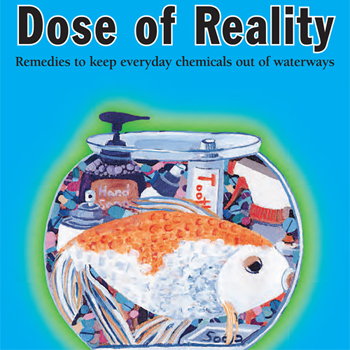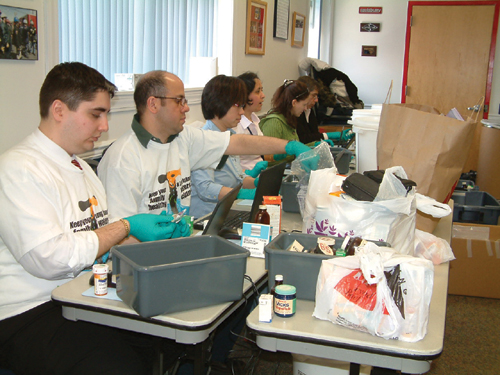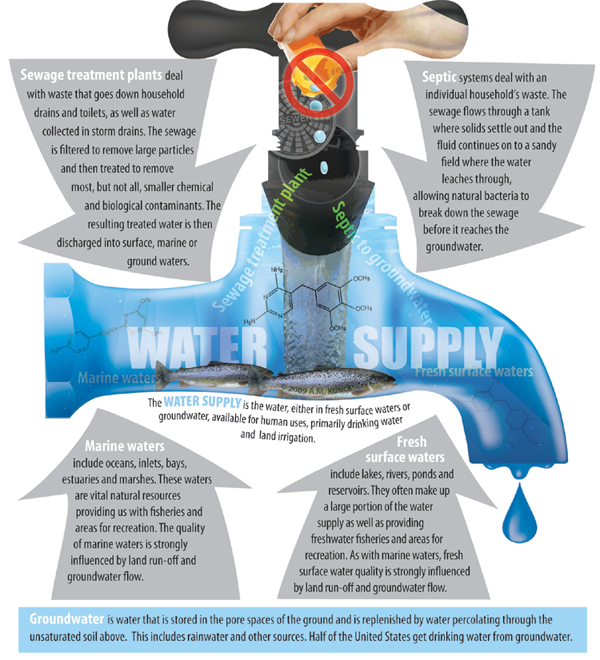New York, NY, May 2, 2014 - On Saturday, April 26, 2014, the U.S. Drug Enforcement Administration held its eight National Prescription Drug Take-Back Day, opening up hundreds of drop-off locations throughout the country so that people could anonymously bring their accumulated expired, unneeded, or unused prescription drugs nd dispose of them safely and responsibly. For those who missed out on the collection day, you can still safely discard unused, unwanted, or expired medications for safe disposal at a number of locations throughout New York State. The NYS Department of Environmental Conservation has more information via its "
Drugs in New York's Water" Web site.
So, why the need for such collection days and drop-off centers? Unwanted prescription drugs that are improperly disposed of can pollute local waterways, posing a threat to public health, wildlife, and our natural environment. The United States Geological Survey (USGS) has detected trace amounts of antibiotics, hormones, contraceptives, steroids, and other medications in 80% of the water tested throughout the country. Flushing and land-filling unused medications are never the right disposal solutions.
“We want people to stop flushing them down the toilet or the drain,” says New York Sea Grant Coastal Education Specialist
Helen Domske. "We tell people not to flush pharmaceuticals down the drain because it does eventually get out to into the water system."
Through the "Dose of Reality Campaign," Sea Grant programs in five Great Lakes states have worked with law enforcement agencies to reduce the quantity of prescription medications that are washed down sinks and toilets, thereby reducing the risk of biologically active compounds in drugs contaminating lakes, rivers and drinking water sources. The efforts of specialists Domske and other specialists throughout these five Great Lakes Sea Grant programs
—in Pennsylvania, Illinois, Indiana, New York and Ohio
—were recognized in Fall 2013 as a Top 100 Great Lakes Restoration Initiative Success Story. It was the second award that NYSG's Domske had received for this campaign in as many years. In October 2012, the Great Lakes Sea Grant Extension Network bestowed upon her an Outstanding Outreach Award for public education programming related to “Dose of Reality."
A survey by Domske’s Great Lakes Ecology students at the University of Buffalo indicated that a majority of their family and friends lacked awareness about proper disposal techniques. In 2013, the 30 undergraduate students enrolled in this course each provided 10 hours of stewardship activities, which included teaching community members about the importance of properly disposing of unwanted or unused medications.
"It's through efforts such as these that students have seen how humans can negatively impact the environment," says Domske. "But, more importantly, by experiencing how their actions can make positive changes, they now understand they can personally play a part in protecting the environment."

Another way in which Domske has helped consumers learn how to properly keep pharmaceuticals and personal care products (PCPs) out of surface waters is through the publication she authored, “
Undo the Environmental Chemical Brew: Keep Unwanted Medications & Chemicals Out of the Great Lakes” (
pdf). "Brew" was co-produced by New York, Illinois-Indiana, Ohio and Pennsylvania Sea Grant programs with funding through the Environmental Protection Agency's Great Lakes Restoration Initiative.
Domske’s four-page primer
—which highlights points made in a 12-page Dose of Reality publication (
pdf)
—covers the impact of such substances as antibiotics, antidepressants, birth control pills, cosmetics, and even vitamins on the freshwater Great Lakes system that supplies drinking water to 42 million people in the U.S. and Canada.
Since the Dose of Reality campaign's inception several years ago, more than 2 million pills were collected at drug drop-off events in the five states. As for the overall success of the "National Take Back Days" themselves, the USDEA reported in November 2013 that during the seventh day since inception of the series in Fall 2010, citizens turned in 647,211 pounds (324 tons) of expired and unwanted medications for safe and proper disposal at the 5,683 take-back sites that were available in all 50 states, the District of Columbia, and U.S. territories. This marked the second-largest collection of medications in the series, during which the DEA and its state, local, and tribal law-enforcement and community partners have removed over a combined 3.4 million pounds (1,733 tons) of medication from circulation.
"These take-back events highlight the problems related to prescription drug abuse and provide a unique and meaningful service to our citizens," said DEA Administrator
Michele M. Leonhart. "While we continue to finalize a uniform system for prescription drug disposal, we will continue to sponsor these take-back opportunities and give Americans the opportunity to contribute to the solution. DEA is grateful to the many federal, state, local, and tribal partners that have helped make this effort so successful."
— Paul C. Focazio, NYSG's Web Content Manager

Volunteer pharmacists from the Stony Brook Medical Center sift through the unused pharmaceuticals dropped off from some 140 participants at a 2009 "Return Unwanted Medicines" event held in Stony Brook, NY. During the one-day event, approximately 88,000 pills were collected as well as nearly 4 liters of liquids and 8 kilograms of powder. Partners at this event, the first of its kind to involve New York Sea Grant, also included the U.S. Environmental Protection Agency’s Long Island Sound Study, Stony Brook University, Stony Brook University Hospital, Suffolk County Legislator Lynne C. Nowick’s office, Triumvirate Environmental, Inc., NYS Department of Environmental Conservation, Suffolk County Department of Health Services and Suffolk County Water Authority.
Photo by Barbara A. Branca.

When pharmaceuticals are flushed, they enter household septic systems or
sewage treatment plants and can make their way into our waterways or
even water supply. Follow the diagram to see how. Information courtesy
of Stony Brook University (SBU) School of Marine and Atmospheric
Sciences researcher Dr. Henry Bokuniewicz and SBU graduate student Ruth
Coffey.
Illustration by Anita Kusick.
More Info: New York Sea Grant
New York Sea Grant (NYSG), a cooperative program of Cornell University
and the State University of New York, is one of 33 university-based
programs under the National Sea Grant College Program (NSGCP) of the
National Oceanic and Atmospheric Administration (NOAA). The NSGCP
engages this network of the nation’s top universities in conducting
scientific research, education, training and extension projects designed
to foster science-based decisions about the use and conservation of our
aquatic resources. Through its statewide network of integrated
services, NYSG has been promoting coastal vitality, environmental
sustainability, and citizen awareness about the State’s marine and Great
Lakes resources since 1971.
For updates on Sea Grant activities:
www.nyseagrant.org has RSS,
Facebook,
Twitter, and
YouTube links. NYSG also offers a free e-list sign up via
www.nyseagrant.org/coastlines for
NY Coastlines, its flagship publication, which, in 2014, merges with the program's e-newsletter,
Currents.
NY Coastlines is published several times a year.